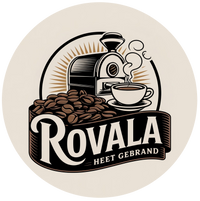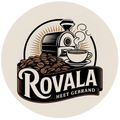Brewing tips
Brewing Tips – Finding the Sweet Spot
Brewing coffee is both an art and a science. Every cup is a balance of flavors, shaped by how water extracts compounds from the beans. Some people love diving into the details, others just want quick answers. That’s why we’ve broken this page into sections you can scroll through at your own pace.
Contents
- Rest time after roasting
- The science of extraction
- Light vs. dark roasts
- Over-extraction in light vs. dark roasts
- General brewing tips
- Device-specific tips
- Roast-specific adjustments
- Summary
- Troubleshooting quick fixes
Rest time after roasting
Freshly roasted beans release CO₂ for several days. Too much gas in the beans can cause:
- Espresso: unstable crema, spurting shots, sour or sharp flavor.
- Filter brews: uneven bloom, “hollow” taste.
As beans rest, flavors settle and sweetness emerges. Think of it like fruit ripening:
- Too soon = green, sharp.
- Too late = dull, woody.
- Just right = balanced and flavorful.
Resting Guidelines
-
Espresso (needs the longest rest)
- Light roasts: 7–14 days (often best at 14–21).
- Medium roasts: 5–10 days (peak around 7–14).
- Dark roasts: 3–7 days (peak around 5–10).
-
Filter brews (more forgiving)
- Light roasts: 3–7 days (sometimes peak at 7–10).
- Medium roasts: 2–5 days.
- Dark roasts: 1–3 days (degas quickly).
Cupping / sample tasting: Professionals often taste just 24 hours after roast — but this is for evaluation, not for enjoying at its best.
Quick Reference
- Light roast espresso → 10–14+ days
- Light roast filter → 4–7 days
- Medium roast espresso → 5–10 days
- Medium roast filter → 2–5 days
- Dark roast espresso → 3–7 days
- Dark roast filter → 1–3 days
The science of extraction
When hot water meets ground coffee, flavors are released in stages:
- Acids and fruity notes extract first.
- Sweetness and balance come next.
- Bitterness and heavier compounds arrive last.
That’s why grind size, brew ratio, and brew time matter so much.
- Under-extraction (too little dissolved): Tastes sour, sharp, acidic, sometimes even salty. Caused by too coarse a grind, water that’s too cool, or too short a brew.
- Over-extraction (too much dissolved): Tastes bitter, harsh, drying/astringent, sometimes “hollow.” Caused by too fine a grind, too hot water, or too long a brew.
The goal: land right in the middle — where acidity, sweetness, and body all play in harmony.
Light vs. dark roasts
Not all roasts behave the same way. The level of roast changes how easily flavors are extracted:
- Light roasts: Dense beans with floral, fruity, and complex acidic notes. They’re less soluble and need more energy — finer grind, hotter water, longer contact — to hit their sweet spot.
- Dark roasts: Fragile beans where the cell structure is already broken down. They extract quickly, lean toward bitterness and smoky “roasty” flavors, and are easy to overdo.
Over-extraction in light vs. dark roasts
- Light roasts: What looks like “over-extraction” in a dark roast may actually bring a light roast into balance. Pushing extraction a bit further often improves clarity and sweetness, taming sharp acidity. But push too far and you’ll still find bitterness, papery notes, and astringency.
- Dark roasts: Already quick to give up their solubles. Even a small overshoot exaggerates bitterness, ash, and charred notes. Almost never pleasant when pushed too far.
General brewing tips
-
Grind size
- Too coarse → sour, thin (under-extracted).
- Too fine → bitter, dry/astringent (over-extracted).
- Dial in until acidity, sweetness and body are in balance.
-
Water temperature
- Light roasts → hotter (94–96 °C) to unlock solubles.
- Dark roasts → cooler (90–92 °C) to avoid extra bitterness.
-
Brew ratio (coffee : water)
- Filter: 1:15–1:17
- Espresso: 1:2–1:3
- French Press: ~1:12
-
Brew time
- Too short = under-extracted.
- Too long = over-extracted.
-
Agitation / stirring
- Increases extraction but can overdo it — use strategically.
-
Freshness
- Rest beans ~4–14 days post roast, especially for espresso.
-
Water quality
- Filtered, ~70–150 ppm hardness, neutral-ish pH.
Device-specific tips
Hario V60 (pour-over)
- Grind: Medium-fine (like sand, not powder).
- Water temp: 92–96 °C, hotter for light roasts.
- Ratio: 15–18 g coffee per 250 g water (≈1:16).
-
Technique:
- Rinse filter with hot water to remove paper taste + preheat.
- Bloom with ~2–3× coffee weight water (30–45 s).
- Pour in concentric circles, keeping bed flat.
- Total brew time: ~2:30–3:30.
- Tip: If sour → finer grind / slower pour. If bitter → coarser grind / faster flow.
Clever Dripper (immersion + drip hybrid)
- Grind: Medium (between drip & French Press).
- Water temp: 92–95 °C.
- Ratio: 18 g coffee per 300 g water (≈1:16–1:17).
-
Technique:
- Add water first or coffee first (both work, stir for consistency).
- Steep ~2:30–3:30 min.
- Place on cup/server → drains in ~1:30–2:00.
- Total: ~4–5 min.
- Tip: Great balance of clarity (like pour-over) + body (like immersion). Very forgiving.
AeroPress Original
- Grind: Medium-fine (like V60 or slightly finer).
- Water temp: 85–95 °C (lower for fruity clarity, higher for body).
- Ratio: 14–18 g coffee for 200 g water (~1:12–1:14). Can be brewed “concentrated” then diluted.
-
Technique:
- Inverted or standard — both fine.
- Bloom briefly, stir/agitate 10–15 s.
- Steep 1–2 min.
- Press gently over 20–30 s.
- Tip: Longer steep + finer grind = bolder. Shorter steep + coarser grind = cleaner.
French Press (press pot)
- Grind: Coarse (breadcrumbs-level).
- Water temp: 92–95 °C.
- Ratio: 30 g coffee per 500 g water (~1:16).
-
Technique:
- Add coffee + water, stir well.
- Steep 4 min → stir → skim foam → press gently.
- For cleaner cup: after 4 min, let it sit 5–8 min more before pressing — grounds settle, less sludge.
- Tip: Don’t plunge hard → can release bitter fines. French Press tends toward body, so pick beans with chocolate/nut notes.
Roast-specific adjustments
- Light roasts → finer grind, hotter water, longer brew times (avoid under-extraction).
- Dark roasts → coarser grind, cooler water, shorter brew times (avoid over-extraction).
Summary
Brewing coffee is about balance. By adjusting grind size, water temperature, brew time, and ratio depending on your roast level and brewing device, you can consistently land in the sweet spot. And by giving beans a little time to rest after roasting, you’ll taste them at their very best.
- V60 → clarity, acidity, very sensitive to grind.
- Clever Dripper → forgiving, balanced, hybrid style.
- AeroPress → versatile, portable, great for experimenting.
- French Press → rich body, rustic, best with chocolate/nutty beans.
Troubleshooting Quick Fixes
| Problem | Likely Cause | Quick Fix |
|---|---|---|
| Coffee tastes sour / sharp / thin | Under-extraction (too coarse, too short, too cool) | Grind finer, brew longer, use hotter water |
| Coffee tastes bitter / harsh / dry | Over-extraction (too fine, too long, too hot) | Grind coarser, brew shorter, use cooler water |
| Coffee feels hollow / watery | Wrong ratio (too much water) or uneven extraction | Increase coffee dose or adjust pour technique |
| Espresso has sputtering, unstable crema | Too fresh (gas release) | Rest beans longer (7–14+ days for light roasts) |
| Filter bloom is uneven / flat | Too fresh or poor water quality | Rest beans or use filtered water (70–150 ppm) |

